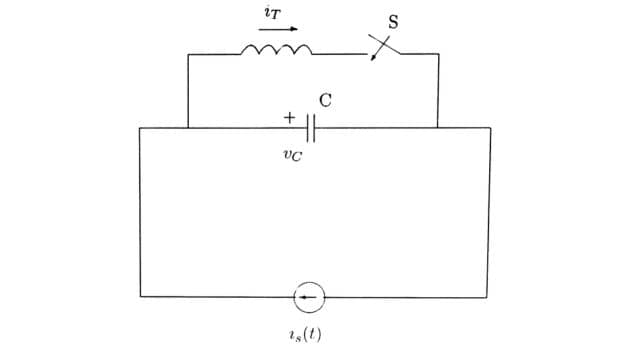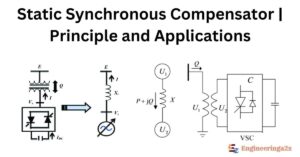
Table of Contents
TCSC
A Thyristor Controlled Series Capacitor (TCSC) is a series FACTS device used as a capacitive reactance compensator. It offers effective solutions because the thyristor allows flexible control. The TCSC is connected in series with the transmission line conductors.
Operation of TCSC
A single line diagram of a TCSC is shown in Fig. which shows two modules connected in series. There can be one or more modules depending on the requirement. To reduce the costs, TCSC may be used in conjunction with fixed-series capacitors.

Each module has three operating modes:
(a) Bypassed: Here the thyristor valves are gated for 180◦ conduction (in each direction) and the current flow in the reactor is continuous and sinusoidal. The net reactance of the module is slightly inductive as the susceptance of the reactor is larger than that of the capacitor. During this mode, most of the line current flows through the reactor and thyristor valves with some current flowing through the capacitor. This mode mainly protects the capacitor against overvoltages (during transient overcurrents in the line). This mode is also termed as TSR (thyristor-switched reactor) mode.

(b) Inserted with Thyristor Valve Blocked: In this operating mode no current flows through the valves with the blocking of gate pulses. Here, the TCSC reactance is the same as that of the fixed capacitor and there is no difference in the performance of TCSC in this mode with that of a fixed capacitor. Hence this operating mode is generally avoided. This mode is also termed as waiting mode.

(c) Inserted with Vernier Control: In this operating mode, the thyristor valves are gated in the region of (αmin < α < 90◦ ) such that they conduct for the part of a cycle. The effective value of TCSC reactance (in the capacitive region) increases as the conduction angle increases from zero. αmin is above the value of α corresponding to the parallel resonance of TCR and the capacitor (at the fundamental frequency). In the inductive vernier mode, the TCSC (inductive) reactance increases as the conduction angle is reduced from 180◦

Generally, vernier control is used only in the capacitive region and not in the inductive region.
Analysis of TCSC
To understand the vernier control operation of TCSC, it is necessary to analyze the TCSC circuit.

For simplicity, it is assumed that the line current is specified and can be viewed as a current source. The equations are:
C . dvC / dt = is(t) − iT
L . diT / dt = vCu
where u = 1 when the switch is closed and u = 0 when it is open. The current in the thyristor switch and the reactor (iT ) is zero at the instant when the switch is opened. Note that when u = 0, and the initial current iT = 0, it remains at the zero value until S is turned on and u = 1. The line current is defined by,
iS(t) = Im cos ωt
It is convenient to measure the firing angle (α) from the zero crossing instant of the line current. It can be shown that the zero crossing of the capacitor voltage (vC) coincides with the peak value of the line current in a steady state. The range of α is from 0 to 90◦ corresponding to the conduction angle varying from 180◦ to 0◦. The angle of advance (β) is defined as:
β = 90◦ − α
which also varies from 0 to 90◦. Fig. shows the waveforms of is(t), iT(t) and vC(t) with delay angle (α), angle of advance (β), and conduction angle (σ) indicated.

Control of TCSC
The control of TCSC also includes protective functions (protective bypass). The control functions are partitioned into two levels – common (to all modules) and the module ( level ). Commands for the control flow from the common level to the module levels while the status information is sent back
from each module level.
Frequently Asked Questions (FAQs)
What is the operation and control of TSSC?
The operating principle of the TSSC is simple: it controls the level of series compensation in steps by adjusting the number of series capacitors in the circuit. This is done by turning off a thyristor valve to insert a capacitor and turning it on to bypass the capacitor.
What is the full form of TCSC?
Thyristor-Controlled Series Capacitor (TCSC)
What are the modes of operation of TCSC?
The TCSC operates in four modes: Blocking, Bypass, Capacitive, and Inductive. The TCSC’s impedance is made up of both capacitor and inductor reactance, as shown in equation (1). The inductive reactance, jX L (α), depends on the firing angle (α) of the thyristors (M. Zellagui, and A. Chaghi, 2012).












Leave a Reply